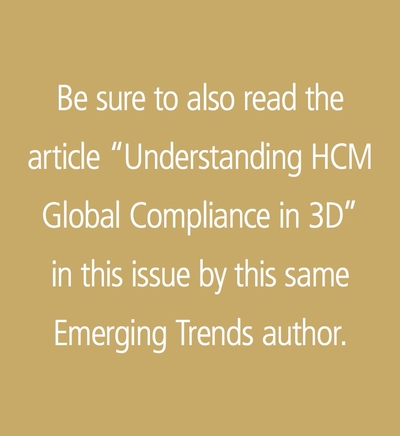All of these external pressures create an emphasis on setting up your service model for success. When you have teams in offices across the globe responsible to manage their individual payroll and human resources, it can be a burden and a process paperwork challenge.
With a shared service environment, companies can standardize processes and more easily enable new technology across the globe. This includes leveraging employee and manager self-service to reduce HR and payroll departments’ workload. However, companies are all different, so finding the right balance is a challenge. Shared service environments are an important opportunity for every global business to consider.
When putting together a potential vendor list, it is important to ensure the vendors' technology and service strategy aligns with your company’s plans. It is important to look at all aspects and offerings of each vendor and technology so that organizations can better determine if a single global provider or multiple providers will offer the best solution to meet company needs.
2. Is there a frequently asked question that you think will no longer be part of the conversation in global payroll?
One question that was very common a few years ago but is now a given is, “Should I consider global cloud technology?” The answer is yes! The speed of cloud technology adoption is staggering. It’s no longer a question for companies; it’s a requirement.
3. How is the changing role of the global payroll professional—typified by greater interaction with the HR department, data analysis, and strategic planning—making an impact in the field?
Today, HCM professionals in general, including payroll and HR, are being asked to provide more strategic value to organizations while focusing less on “transactional,” which has largely become assumed by executives, despite being extremely difficult to produce.
Being more strategic means global payroll professionals need to have better data and analysis to provide management, which can help drive major business decisions for a multinational firm.
4. What resources do you use to stay current on the latest trends and legislation in global payroll?
At Ceridian, we subscribe to several publications, including FedEE for Europe [The Federation of International Employers (FedEE Global)], a leading HR support organization for multinational companies], which helps provide forward-looking information related to payroll, tax, and labor rules. It is also encouraging to see a great focus on global by traditionally domestic-focused publications, including the launch of the Global Payroll Management Institute (GPMI). In addition to industry trade publications and blogs, Ceridian’s network of global payroll partners supplies our customers and colleagues with real-time updates as things change in each country. We also engage with the best analysts in the industry to understand their views on emerging trends, innovation in the marketplace, and also as a sounding board for new ideas.
5. How would you advise someone whose company is just beginning to expand to a global payroll with regard to risk management and compliance?
For companies just starting to expand outside their home markets, it is important to start with the end  goal in mind. First, understand where you want to grow your business and what role you want your HR and payroll teams to play in the long term in delivering payroll, compliance, and risk management. Consider the following three questions:
goal in mind. First, understand where you want to grow your business and what role you want your HR and payroll teams to play in the long term in delivering payroll, compliance, and risk management. Consider the following three questions:
- In order of priority, how would you rank the cost of service, quality, and time to execution or change of your payroll service?
- Do you want to outsource as much as you can? At what cost?
- What processes do you want to maintain control over?
At Ceridian, we view compliance as a partnership—a customer and its vendor partners must work together to remain compliant and react to changing rules. A customer always has a role to play.
From the start, understand how you would want that partnership to look and function. Be sure to do your research. Examine your markets to determine where you run the highest risk today and which markets are the most complex to manage. Be certain that you have the right advisors to guide your HR and payroll strategy.
6. How can a global payroll department integrate on a strategic level with corporate finance, HR, and other departments to provide a competitive advantage?
The first step for a global payroll department to integrate on a strategic level with corporate finance, human resources, and others is to bring your data!
Payroll, if managed well and if using modern technology, can be a gold mine for detailed data that can help executives and functional leaders drive their business. I see the market moving toward a more strategic view of payroll and a new set of KPIs emerging. One is focused on understanding labor spend at a detailed level, as corporate executives want to understand in real time how their global business is performing. By seeing detailed labor spend in real time, you can understand if certain locations are over budget, see where corporate taxes affect your bottom line, and see where you should invest in additional labor to reduce compliance risk or overtime pay.
If you’re focused on risk management, especially as it pertains to compliance, real-time visibility to data will reveal if you’re paying wages within the bounds of a particular country’s minimum wages and collective bargaining or union agreements. Additionally, you’ll be able to see if you’re paying employees in certain locations outside of normal pay periods more often and if it could create employee engagement risk or, even worse, a strike.
7. How has your approach to change management helped to make a successful organization?
If you approach change management as a reality of everyday life, and your team is used to constant  change, you’re in a position to innovate and win. I tend not to think of change management as a “program” or an approach, but rather a fact of every workday. I’ve spent my career in technology and consulting, two places where change is constant. But change is constant across all industries, and if it’s not a part of your firm or teams it is most likely time to understand why not. Based on my experience, I try to create environments where employees are empowered to talk to customers, talk to other functions, and talk to external analysts so that we can lead the market and see the change we need to make ahead of time. One of our five core values at Ceridian is agility. The following definition of agility aligns with my view on successfully managing change: “We are flexible and innovative. We confront all challenges with enthusiasm. We encourage change in order to achieve success.”
change, you’re in a position to innovate and win. I tend not to think of change management as a “program” or an approach, but rather a fact of every workday. I’ve spent my career in technology and consulting, two places where change is constant. But change is constant across all industries, and if it’s not a part of your firm or teams it is most likely time to understand why not. Based on my experience, I try to create environments where employees are empowered to talk to customers, talk to other functions, and talk to external analysts so that we can lead the market and see the change we need to make ahead of time. One of our five core values at Ceridian is agility. The following definition of agility aligns with my view on successfully managing change: “We are flexible and innovative. We confront all challenges with enthusiasm. We encourage change in order to achieve success.”